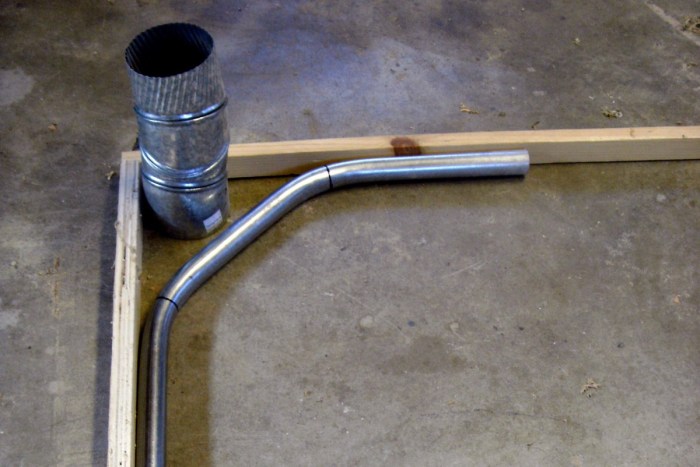Back to back conduit bends – In the realm of electrical installations, back-to-back conduit bends play a crucial role in ensuring the safe and efficient routing of wires and cables. This guide delves into the intricacies of these bends, exploring their types, methods of creation, and practical applications.
From residential settings to industrial environments, back-to-back conduit bends enhance electrical safety, organization, and aesthetics. Discover the techniques and considerations involved in designing and implementing these bends, ensuring optimal performance and compliance with industry standards.
Definition and Purpose of Back-to-Back Conduit Bends
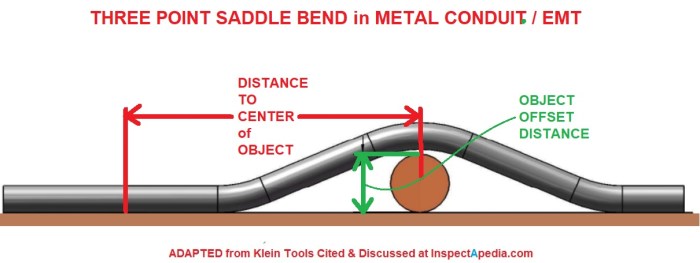
Back-to-back conduit bends refer to a specific arrangement of conduit fittings where two or more bends are connected consecutively without any straight conduit sections in between. This configuration is commonly employed in electrical installations to navigate obstacles, change the direction of conduits, or achieve specific angles.
Back-to-back conduit bends are advantageous in situations where space is limited, or when it is necessary to avoid creating excessive slack in the conduit. They allow for precise alignment and smooth transitions, ensuring the proper flow of electrical cables and wires through the conduit system.
Back to back conduit bends provide a convenient way to change the direction of a conduit run, making them useful for navigating obstacles or tight spaces. Similar to the multifaceted work of Audre Lorde, who explored the intersections of age, race, and class here , back to back conduit bends offer a versatile solution for electrical installations.
Applications of Back-to-Back Conduit Bends
- Changing the direction of conduits around corners or obstacles
- Navigating tight spaces or avoiding obstructions
- Achieving specific angles or offsets in conduit runs
- Creating bends in vertical or horizontal conduit sections
- Providing flexibility and maneuverability in conduit installations
Types of Back-to-Back Conduit Bends: Back To Back Conduit Bends
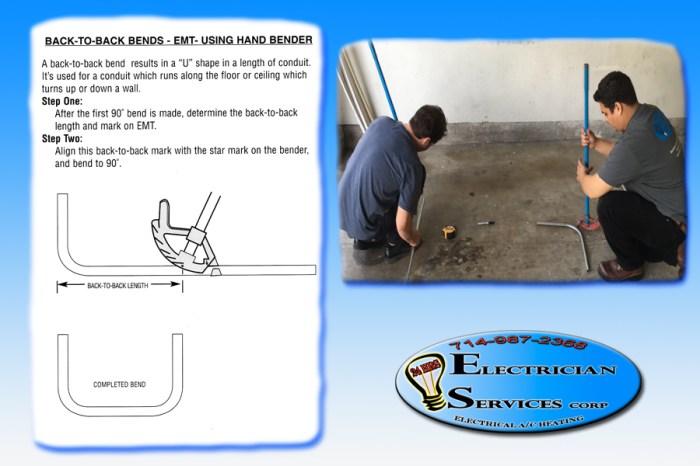
Back-to-back conduit bends, also known as double bends, come in various types, each designed for specific applications. These bends provide smooth transitions in conduit runs, allowing for changes in direction without compromising the integrity of the conduit system.
90-90 Degree Bends
90-90 degree bends are the most common type of back-to-back bends. They consist of two 90-degree bends placed back-to-back, creating a 180-degree change in direction. These bends are ideal for sharp turns and tight spaces, providing a compact and efficient way to navigate obstacles.
45-45 Degree Bends
45-45 degree bends are used to create gradual changes in direction. They consist of two 45-degree bends placed back-to-back, resulting in a 90-degree change in direction. These bends are suitable for longer runs where a more gradual turn is required, reducing stress on the conduit and cables.
45-90 Degree Bends
45-90 degree bends combine the features of 45-degree and 90-degree bends. They consist of a 45-degree bend followed by a 90-degree bend, creating a 135-degree change in direction. These bends are versatile and can be used in various scenarios, such as transitioning between vertical and horizontal conduit runs or making turns around corners.
Custom Bends, Back to back conduit bends
In addition to these standard types, custom back-to-back bends can be fabricated to meet specific requirements. These bends are designed and manufactured to accommodate unique angles and configurations, providing flexibility in conduit routing and installation.
Methods for Creating Back-to-Back Conduit Bends
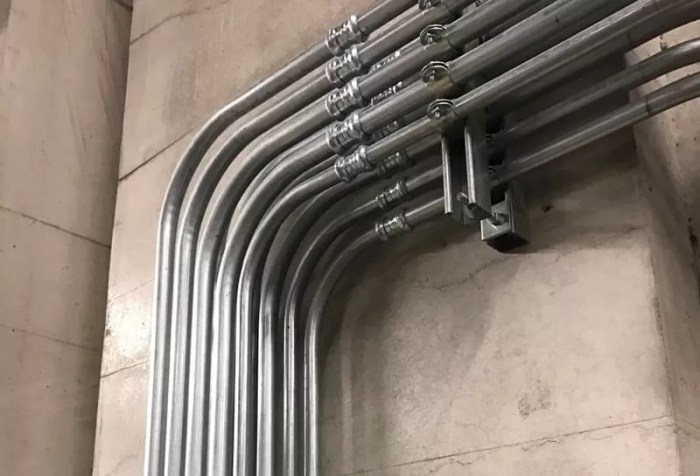
Creating back-to-back conduit bends requires careful planning and precise execution. Several methods can be employed to achieve accurate and efficient bending, including manual techniques and the use of specialized tools and equipment.
Manual Bending Technique
The manual bending technique involves using a conduit bender, a handheld tool that allows for precise bending of conduit. To create back-to-back bends manually, follow these steps:
- Mark the conduit at the desired bend locations.
- Place the conduit in the conduit bender and secure it.
- Bend the conduit to the first desired angle.
- Measure and mark the second bend location on the conduit.
- Reposition the conduit in the bender and bend it to the second desired angle.
- Check the accuracy of the bends using a protractor or angle gauge.
Specialized Tools and Equipment
Specialized tools and equipment can simplify and enhance the efficiency of creating back-to-back conduit bends. These tools include:
- Hydraulic conduit benders:These powerful tools use hydraulic pressure to bend conduit accurately and quickly.
- Electric conduit benders:Electric benders offer a convenient and portable option for bending conduit.
- Rotary conduit benders:Rotary benders allow for continuous bending of conduit, making them ideal for creating complex bends.
Considerations for Back-to-Back Conduit Bend Design

The design of back-to-back conduit bends is crucial for ensuring efficient wire pulling and preventing damage to the conduit and wires. Several factors must be considered to optimize bend design, including bend radius, conduit size, and bend angles.
Bend Radius and Wire Pulling
Bend radius refers to the distance from the center of the conduit to the outer edge of the bend. A smaller bend radius makes the bend tighter, while a larger bend radius creates a more gradual curve. The bend radius is critical for wire pulling, as a tighter bend can make it difficult to pull wires through the conduit.
The recommended bend radius for back-to-back bends depends on the conduit size. Generally, a bend radius of at least 6 times the conduit diameter is recommended for easy wire pulling. A larger bend radius may be required for larger conduit sizes or when pulling multiple wires.
Conduit Size and Bend Angles
The size of the conduit also influences the design of back-to-back bends. Larger conduits require larger bend radii to maintain a smooth curve. The bend angle should be selected based on the conduit size and the desired path of the conduit.
For back-to-back bends, the bend angles should be equal and opposite. This ensures that the conduit maintains a straight path after the bends. The sum of the two bend angles should be less than 180 degrees to prevent overbending and damage to the conduit.
Recommended Bend Radii for Different Conduit Sizes
The following table summarizes the recommended bend radii for different conduit sizes:
| Conduit Size (in) | Recommended Bend Radius (in) |
|---|---|
| 1/2 | 3 |
| 3/4 | 4.5 |
| 1 | 6 |
| 1-1/4 | 7.5 |
| 1-1/2 | 9 |
| 2 | 12 |
Applications and Examples of Back-to-Back Conduit Bends
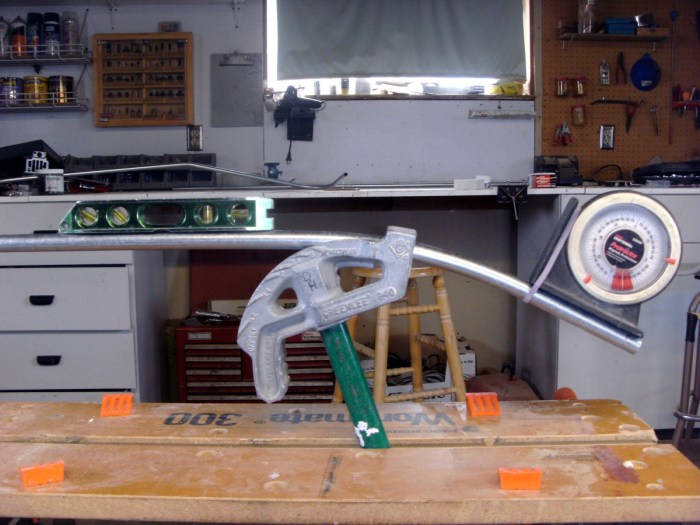
Back-to-back conduit bends serve diverse applications in electrical installations, enhancing safety and organization.
In residential settings, these bends are commonly used for routing wires around obstacles, such as door frames or windows, ensuring a neat and protected wire run. They also find use in commercial buildings, facilitating wire management in congested areas like server rooms or data centers.
Industrial Applications
- In industrial environments, back-to-back conduit bends are essential for safeguarding wiring in hazardous areas, such as chemical plants or manufacturing facilities, where sharp bends can compromise conduit integrity.
- These bends provide a gradual change in direction, reducing stress on the conduit and ensuring electrical safety.
Detailed FAQs
What are the advantages of using back-to-back conduit bends?
Back-to-back conduit bends offer several advantages, including increased flexibility in routing wires and cables, enhanced protection against damage, improved organization and aesthetics, and compliance with electrical codes.
How do I determine the correct bend radius for a given conduit size?
The bend radius is crucial for ensuring proper wire pulling and preventing damage to the conduit. Refer to the table provided in the guide or consult industry standards for recommended bend radii based on conduit size.
What are some common mistakes to avoid when creating back-to-back conduit bends?
Common mistakes include using too small a bend radius, overbending the conduit, and not properly supporting the conduit during bending. These mistakes can lead to damage to the conduit, difficulty pulling wires, and potential electrical hazards.
